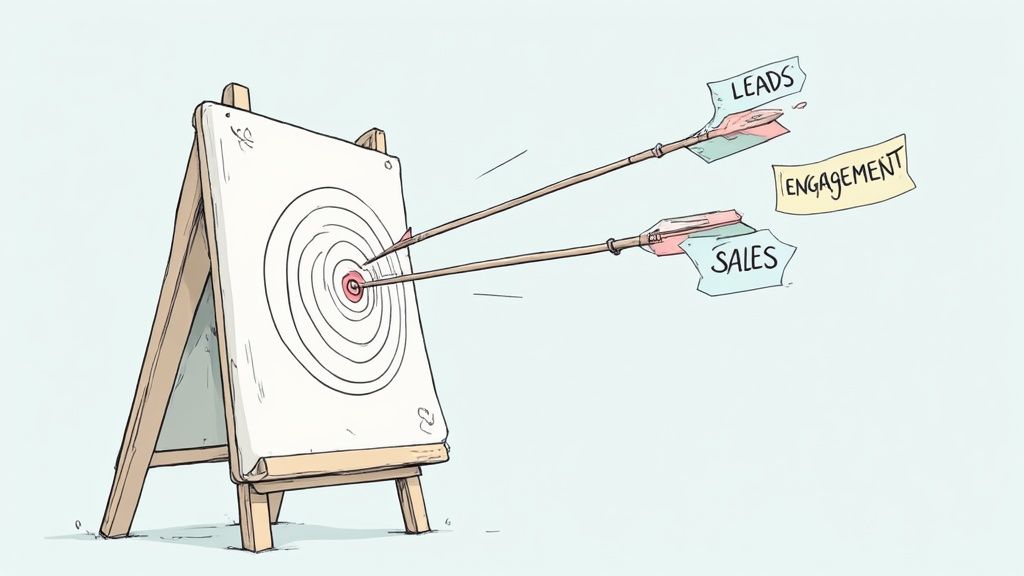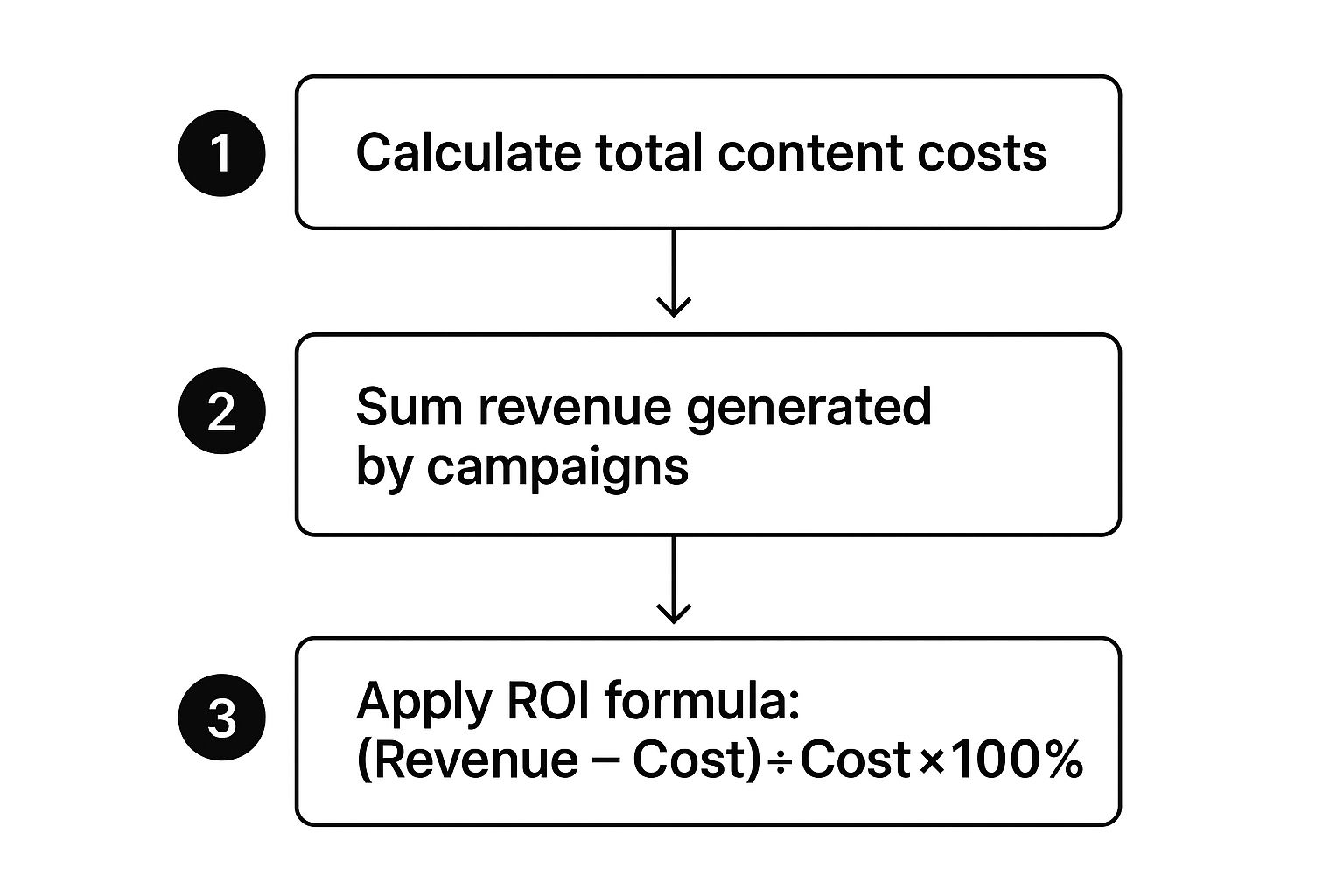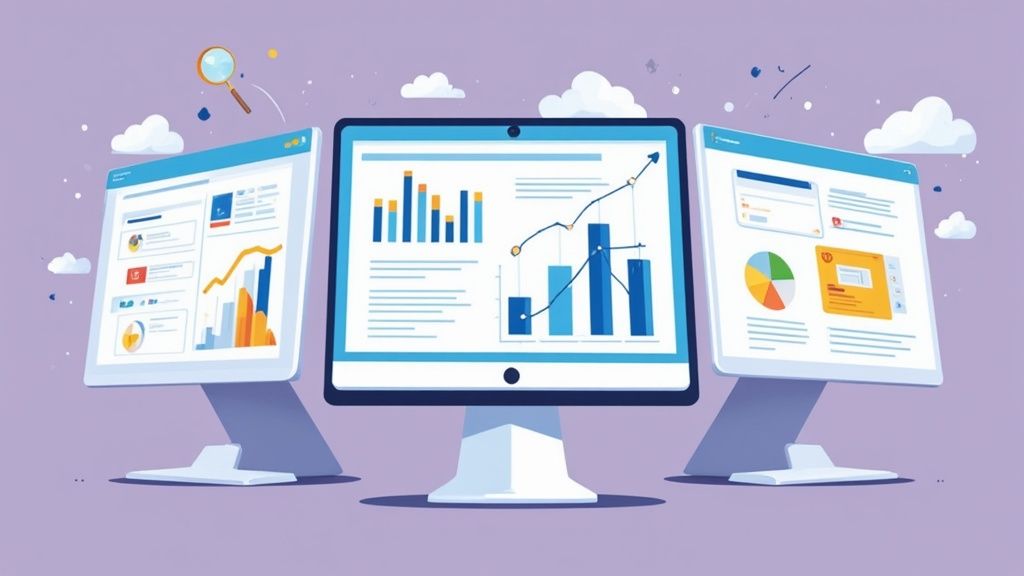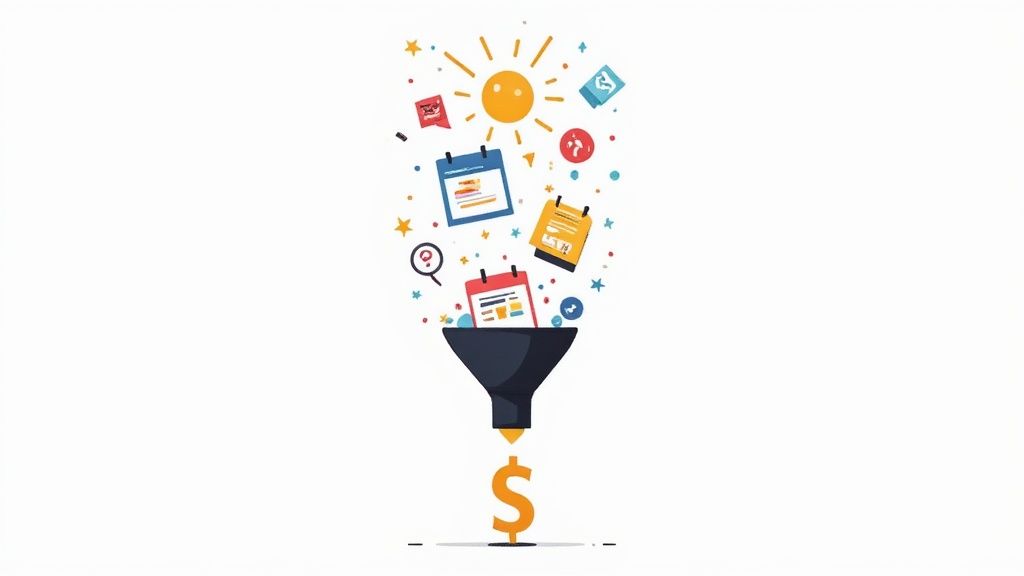Unpacking Your Content Marketing ROI Calculation
To get to that powerful ROI number, you first have to understand the two sides of the financial equation: what you put in and what you get out. It sounds simple, but getting this right is the first step toward building a measurement system you can actually trust.
This table breaks down the typical investments that go into a content program versus the tangible returns you can measure.
| Investment Component (Costs) |
Return Component (Gains) |
| Salaries for your content team |
Direct revenue from content-driven sales |
| Freelancer and agency fees |
Value of new leads generated |
| Software and tool subscriptions (SEO, design, etc.) |
Increased customer retention and lifetime value |
| Paid promotion and ad spend |
Savings from reduced paid ad spend |
Thinking through both columns ensures you're capturing the full picture of your investment and its impact.
When you track everything correctly, the financial upside can be massive. Some analyses have shown a potential return of up to $42 for every dollar spent on content marketing. It's this effectiveness that drives 79% of highly successful companies to dedicate over 10% of their marketing budget to content. If you're interested in diving deeper, Blogging Wizard has a great roundup of these kinds of content marketing trends and statistics.
Setting Goals That Actually Drive Business Value

Before we can even start talking about ROI, we need to get real about what "success" actually means for your content. If you walk into a budget meeting with vague goals like "more traffic" or "better engagement," you're not going to get very far. Those are wishes, not business objectives. The trick is to tie your content efforts directly to outcomes that the CFO actually cares about.
This means shifting your focus from vanity metrics to the stuff that truly impacts the bottom line. The best framework I've found for this, time and time again, is setting S.M.A.R.T. goals. It’s a classic for a reason—it forces you to make your targets Specific, Measurable, Achievable, Relevant, and Time-bound.
From Vague Ideas to Specific Targets
Let's put this into practice. Instead of saying you want "more traffic," a S.M.A.R.T. goal sounds like this: "Increase organic blog traffic by 20% in the next quarter." See the difference? It's concrete, you can measure it, and it has a deadline.
Here’s another one I see all the time. Don't just say you want to "get more leads." A much more powerful goal is, "Generate 50 marketing qualified leads (MQLs) from our new e-book campaign by the end of Q2." Now you have a clear benchmark to evaluate your performance.
Pro Tip: Your goals should always be able to answer two simple questions: "How much?" and "By when?" If you can't answer both, you need to go back to the drawing board.
When you set these clear expectations from the start, you build a bridge between your content team's daily work and the financial health of the business. Suddenly, content isn't just a creative cost center; it's a strategic engine for growth.
Connecting Content to Commercial Impact
To get a full picture of your ROI, you have to look beyond that first click or view. You need to follow the thread through the entire customer journey, from the moment someone first discovers your brand to the day they become a loyal customer. This is how you tell the complete story of your content's value.
Think about organizing your metrics and goals around the marketing funnel:
- Top-of-Funnel Awareness: This is about visibility. Track metrics like organic reach, improvements in keyword rankings, and your overall share of voice. While they don't scream "revenue" on their own, they are the vital early signs of future growth.
- Mid-Funnel Engagement: Here, you want to see if you're attracting the right people. Focus on lead conversion rates from your guides and whitepapers, new newsletter sign-ups, and how long people are actually spending on your pages.
- Bottom-of-Funnel Conversion: This is where the money is. You absolutely need to be tracking customer lifetime value (LTV), customer acquisition cost (CAC), and how much revenue your content has directly influenced.
A truly compelling goal ties it all together. For instance: "Reduce our customer acquisition cost by 15% within six months by increasing organic lead generation through our blog." A goal like this is music to a leadership team's ears. It shows you understand how content solves expensive business problems—and that’s the entire point of proving content marketing ROI.
The Practical Formula for Calculating Content ROI
Alright, let's roll up our sleeves and get into the numbers. Calculating your content marketing ROI might sound like a job for a data scientist, but the truth is it all comes down to a simple, powerful formula you can apply to just about any campaign.
The basic math is actually pretty straightforward:
((Return - Investment) / Investment) * 100 = Content ROI %
This classic formula gives you a clean percentage, which is perfect for comparing the performance of different campaigns side-by-side. For instance, an ROI of 150% tells you that for every dollar you spent, you not only made that dollar back but also pocketed an extra $1.50 in profit.
The real challenge isn't the calculation itself. It’s accurately defining what goes into your "Return" and "Investment" buckets. Nailing these two components is what separates a fuzzy guess from a number you can actually trust.
Tallying Up Your Total Investment
First, let's break down the Investment side of the equation. This is the sum of every dollar you spend to create, publish, and promote your content. Being thorough here is absolutely crucial for getting an accurate picture of your costs.
Your investment costs will typically include a few key areas:
- Production Costs: This is what you pay freelance writers, graphic designers, or video editors. If you have an in-house team, you'll want to calculate a portion of their salaries based on the time they dedicated to the project.
- Tool Subscriptions: Don't forget those recurring monthly fees. We're talking about your SEO software (like Ahrefs or Semrush), design tools (like Canva or Adobe), and social media schedulers.
- Paid Promotion: Any budget you put behind social media ads, search ads, or influencer collaborations to boost your content's reach is a direct cost that needs to be included.
Diligently tracking these expenses can feel like the most tedious part of the process, but it’s foundational. You don't have to be perfect down to the last penny, but capturing all your major costs is essential for a reliable ROI figure.
This visual helps illustrate the basic flow of how your costs and returns come together.

As you can see, the process starts with identifying all your costs, then moves to summing up the revenue before you can apply the final ROI formula.
Identifying Your Financial Return
Now for the other side of the coin: defining your Return. This is the total value your content generates, and it often extends far beyond direct sales. The most obvious returns are the value of new leads generated and the sales revenue you can directly attribute to a piece of content.
However, a truly savvy analysis also factors in cost savings. For example, if a high-ranking blog post starts bringing in organic traffic for a keyword you used to pay for with search ads, that saved ad spend is a very real, tangible return. For a deeper look at all the things you can measure, check out our detailed guide on https://outbrand.design/blog/content-performance-metrics.
The influence of content on purchasing decisions is massive and well-documented. Consider email marketing, a core content channel—it influences the buying decisions of 59% of B2C consumers. Even more impressive, user-generated content (UGC) shapes the choices of an incredible 90% of shoppers, proving the direct link between what people see and what they buy.
To get even more granular with your measurement, it’s worth exploring proven strategies for measuring social media ROI, as many of the principles can be applied to other content channels. By tracking both direct revenue and these indirect financial gains, you start to build a comprehensive view of your content's total business impact.
Building Your Content ROI Tracking Tech Stack

You can't prove your content's worth without the right tools. Seriously, it's that simple. Building a solid tech stack is how you stop guessing and start knowing exactly how your articles, guides, and videos translate into revenue.
The good news? You don’t need a dozen expensive, complicated platforms. The idea is to pick a few key tools that talk to each other and give you the full story—from first click to final sale. Let's break down what you actually need.
Foundational Analytics and Goal Tracking
First things first, you need a powerful analytics platform. For pretty much everyone, that's going to be Google Analytics (GA4). But just installing the tracking code isn’t enough. The real magic happens when you move past vanity metrics like page views and start tracking actions that matter to your business.
This is where custom conversion events come in. Think about what you want people to do on your site. If you're after leads, you should create a specific event that fires every time someone fills out your contact form.
- Goal: Track demo requests that came from reading a new case study.
- Action: Set up a custom event in GA4 that triggers only when the demo form on that case study page is submitted.
- Insight: Now you can see precisely how many qualified leads that single piece of content generated, making it easy to assign a real dollar value to it.
The screenshot above from Google Analytics gives you a glimpse of how you can watch user acquisition, engagement, and conversions in one place. This is ground zero for seeing which content is actually pulling its weight.
SEO and Traffic Value Attribution
Your SEO tools do more than just show you keyword rankings; they’re secretly powerful ROI calculators. Platforms like Ahrefs or Semrush are brilliant at connecting your content's search performance to its financial impact.
A fantastic metric for this is "traffic value." It's an estimate of what you'd have to shell out for the same amount of traffic if you were paying for it through Google Ads. When your content starts ranking for high-value keywords, you can literally watch that traffic value climb. It's a direct cost saving and a crystal-clear return on your content investment.
Connecting Content to Your Sales Funnel
This is the final, crucial piece of the puzzle: linking marketing efforts directly to sales. This is where your Customer Relationship Management (CRM) platform, like HubSpot or Salesforce, becomes your best friend.
When you integrate your CRM with your website analytics, you can finally see the entire customer journey.
You can track a lead from the moment they first land on a blog post, follow them as they download an ebook, and see them finally make a purchase. This complete, end-to-end view is the holy grail for proving content marketing ROI.
It's one thing to know your content gets traffic; it's another to prove it influenced a $10,000 sale.
To pull all this data together in a way that makes sense, you'll want to explore some marketing dashboard examples. They can help you visualize your most important metrics in one place. And for smaller teams looking to punch above their weight, this kind of integration is key. You can learn more about how marketing automation for small businesses makes this entire process manageable.
Your Essential Content ROI Tracking Toolkit
Putting it all together, here’s a look at the core tools you'll need and the specific job each one does in your ROI tracking workflow.
| Tool Category |
Example Tools |
Primary Use Case for ROI Tracking |
| Web Analytics |
Google Analytics (GA4) |
Tracks on-site user behavior, goal completions (like form fills), and assigns conversion values to specific content. |
| SEO Platform |
Ahrefs, Semrush |
Calculates organic traffic value, identifies high-value ranking keywords, and attributes organic traffic to specific pages. |
| CRM |
HubSpot, Salesforce |
Connects marketing touchpoints to leads and sales, enabling full-funnel attribution from first click to closed deal. |
This trio of tools gives you a complete, data-backed picture of your content's financial performance, empowering you to make smarter decisions and prove your value to stakeholders.
Alright, let's transform this section into something an experienced pro would write.
Actionable Strategies to Boost Your Content ROI
https://www.youtube.com/embed/r2qWsMzuDso
Knowing your numbers is one thing, but making them grow is where the real work begins. Once you’ve figured out your baseline ROI, it’s time to roll up your sleeves and start implementing strategies that turn those analytics into actual profit. This is the fun part.
A great place to kick things off is with a content audit. Seriously, dig through your analytics and hunt down those underperforming articles. You're looking for the low-hanging fruit—posts that get decent traffic but don't convert, or pages that used to be on page one and have slowly slipped into oblivion. A simple refresh with updated stats, better visuals, or a more persuasive call-to-action can give you one of the fastest lifts in your content marketing ROI.
Maximize Value Through Repurposing
Stop the content hamster wheel. Instead of constantly creating new things from scratch, get really good at repurposing what you already have. This is all about getting the absolute maximum mileage out of your best work. A single, high-effort piece can easily fuel your content calendar for weeks.
Think about it like this:
- That in-depth guide you spent a month writing? It can become a quick summary video for YouTube and a whole series of informative carousels for Instagram.
- The expert webinar you hosted? Slice it up into bite-sized video clips for TikTok and Reels, a detailed blog post expanding on the key points, and a downloadable checklist for your audience.
- Those powerful stats from your latest case study? Turn them into a sharp-looking infographic that's practically made for sharing on Pinterest and LinkedIn.
This isn't just about saving time—it’s about meeting your audience where they are, with the format they prefer. You’re making your best content work smarter, not harder.
Sharpen Your Conversion Focus
So often, a better content marketing ROI just comes down to better conversion rate optimization (CRO). Every single piece of content needs to have a job to do, gently guiding the reader toward a specific action. Take a hard look at your calls-to-action (CTAs). Are they clear and compelling, or are they passive and easy to scroll past?
Don't just settle for a weak "learn more." Give your audience a specific, high-value next step. Something like "Download Our Free SEO Checklist" or "Get Your Personalized Demo" is direct and makes a world of difference.
This is where lead magnets shine. Offer up genuinely useful resources—checklists, templates, exclusive guides—that solve a real problem for your reader. By giving them something tangible in exchange for their email, you're turning casual visitors into qualified leads. This directly boosts the measurable return on that piece of content. If you want to take it a step further, explore some advanced content marketing tips for compelling storytelling to make your offers even more irresistible.
The data also points heavily toward video. For 71% of video marketers, short-form videos are the top ROI driver. In fact, 45% of all marketers now agree that video delivers the highest performance of any content type, which is a pretty clear signal on where to invest for better returns.
Got Questions About Measuring Content ROI? We've Got Answers.
Even with the best formulas laid out, putting content marketing ROI into practice can feel a bit messy. It's one thing to see the math on a screen and another to apply it to your real-world campaigns. It’s completely normal to hit a few roadblocks when you move from theory to execution.
Let's walk through some of the most common questions and sticking points that trip marketers up. My goal is to help you get clear, confident answers from your data.
"How Long Should I Wait Before Measuring?"
This is probably the biggest hurdle for most people. Content marketing isn't like a PPC ad; it's a long game. A great blog post you publish today might not really hit its stride and start pulling in serious traffic or leads for another six months, sometimes longer.
So, what's the right timeframe?
There's no single magic number, but here’s how experienced pros approach it. You need different measurement windows for different things.
- For a specific, time-bound campaign, like an ebook launch, a 90-day window is usually a solid benchmark. It’s enough time to capture the initial buzz and conversions.
- For your overall content program, think bigger. You should be looking at performance on a quarterly and even annual basis to truly understand the cumulative, long-term impact of your work.
"How Do I Assign a Dollar Value to Something That Isn't a Sale?"
Ah, the classic question. What's a new newsletter subscriber really worth? Or a free trial signup? If you can't connect these "non-monetary" conversions to actual revenue, your ROI calculation will always feel flimsy and incomplete.
The trick is to work backward from a number you do know: how much a customer is worth.
First, figure out your lead-to-customer conversion rate. Let's say you know from your data that 10% of people who join your newsletter eventually buy from you. And let's imagine your average customer lifetime value (LTV) is $500.
Now you can do some simple math.
Lead Value = (LTV x Lead-to-Customer Rate)
Using our example, each new newsletter subscriber is worth $50 ($500 x 0.10).
Just like that, your "non-monetary" conversion has a real dollar value. You can plug that $50 right into your ROI formula and measure with confidence.
"What About My Top-of-Funnel Content?"
This one comes up all the time. What do you do with those articles, videos, or social posts that are all about building brand awareness and don't directly ask for a lead? It's a huge mistake to just write them off as having zero value.
Direct attribution here is definitely tough, but you can use some smart proxies to estimate their financial contribution.
One of the best ways to do this is by looking at the "traffic value" metric you can find in SEO tools like Ahrefs. This metric estimates what you would have had to pay for the same amount of organic traffic if you were buying it through paid search ads.
Here’s a quick scenario:
- A blog post you wrote is now bringing in 1,000 organic visitors every month.
- The tool estimates the average cost-per-click (CPC) for its main keywords is $3.00.
- This means the monthly traffic value of that single post is $3,000.
This represents a tangible cost saving. You would have had to spend that much on ads to get the same result. That’s a clear return on your investment, proving that even awareness-focused content has a measurable impact on your bottom line.
Ready to stop guessing and start creating high-impact content that delivers real results? OutBrand uses AI to generate a full month of on-brand social media content in minutes, complete with visuals and captions. Transform your content workflow and drive measurable growth. Discover how OutBrand can elevate your strategy.



